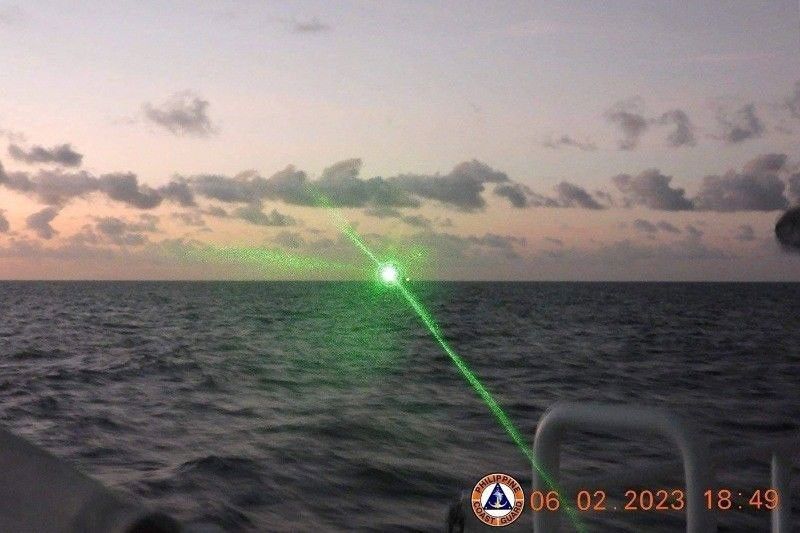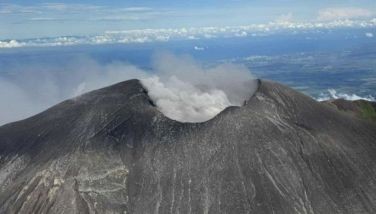… but laser incident not enough to activate MDT

MANILA, Philippines — The Chinese coast guard’s use of a powerful laser to stop a Philippine patrol vessel from helping resupply a military outpost in Ayungin Shoal was clearly an act of aggression, but not enough for him to invoke the 1951 Mutual Defense Treaty (MDT) with the United States, President Marcos said yesterday.
“Despite the fact that it was a military-grade laser that was pointed at our coast guard, I do not think that that is sufficient for it to trigger the Mutual Defense Treaty,” Marcos told reporters after an alumni homecoming event at the Philippine Military Academy (PMA) in Fort Del Pilar, Baguio City.
It was his first public remarks about the Feb. 6 incident involving two Chinese and Philippine coast guard vessels near Ayungin (Second Thomas) Shoal.
The beaming of military-grade laser light on Philippine Coast Guard vessel BRP Malapascua on Feb. 6 briefly blinded its crew.
The incident prompted Marcos to summon Chinese Ambassador Huang Xilian to Malacañang and the Department of Foreign Affairs (DFA) to file a diplomatic protest.
At a news conference, Marcos also reminded China’s ambassador that escalating aggression and incursions into Philippine waters would violate an agreement he struck with Chinese President Xi Jinping last month.
Responding to a question, Marcos said he was concerned that activating the 1951 Philippine-US Mutual Defense Treaty would ratchet up regional tensions.
Marcos spoke to reporters in Baguio City where he delivered a speech before cadets and former graduates of the PMA and repeated a vow to defend the country’s territory amid a new territorial spat with China.
“We will work with our neighbors to secure the safety and security of our peoples,” Marcos said without elaborating.
Like his predecessor, Rodrigo Duterte, Marcos has taken steps to nurture friendly ties with Beijing. He met Xi in the Chinese capital early last month to boost relations and discuss the Asian neighbors’ long-seething territorial disputes in the strategic waterway that also involve Vietnam, Malaysia, Taiwan and Brunei.
China claims the South China Sea virtually in its entirety, putting it on a collision course with other Asian claimants and separately with Washington, which lays no claims to the disputed sea but has deployed its Navy ships and fighter jets to patrol the waters, promote freedom of mobility and challenge China’s territorial claims.
The contested waters have become a delicate front in the broader rivalry between the US and China in Asia and elsewhere.
Measuring distance
China has repeatedly defended its action in Ayungin, saying its coast guard ship used a hand-held laser and another light-emitting gadget to harmlessly measure the distance and speed of the Philippine vessel, which it claimed intruded into Chinese territorial waters and was warned to leave the area.
But US State Department spokesman Ned Price said China’s “dangerous operational behavior directly threatens regional peace and security, infringes upon freedom of navigation in the South China Sea as guaranteed under international law.”
Washington, he said, was standing by its treaty ally Manila following the latest sea incident.
Price renewed a warning that an armed attack on Philippine military forces, public vessels or aircraft, including those of the coast guard in the West Philippine Sea, would invoke US mutual defense commitments under the 1951 treaty.
Australia, Japan, Canada, Germany, Denmark and the United Kingdom also expressed alarm following the Chinese coast guard’s use of the military-grade laser against the Philippine patrol vessel that they said threatens regional peace and stability.
“If we activated that, what we are doing is escalating, intensifying the tensions in the area and I think that would be counterproductive,” Marcos told reporters when asked if the laser-pointing incident was enough to enable the MDT.
Marcos said he discussed with China’s ambassador what he considered intensifying actions of Chinese marine militia, coast guard and navy, including the laser pointing incident.
China’s recent actions came just a month after Marcos’ state visit to Beijing, where the two countries pledged to handle disputes peacefully and boost cooperation.
China claims large swathes of the strategic waterway, a claim invalidated by an international tribunal in The Hague in 2016.
During her visit to the Philippines in November last year, US Vice President Kamala Harris reaffirmed her country’s commitment under the MDT in the event of an armed attack in the South China Sea and West Philippine Sea.
‘Constant contact’
Marcos said the Philippines is in “constant contact” with its treaty partners, not only the US but also with its allies in the Association of Southeast Asian Nations (ASEAN).
“That I think is the better recourse rather than to go directly to the Mutual Defense Treaty which again, I am very concerned would provoke the tensions rather than cool the tensions down,” he said.
The Philippines and Japan earlier agreed to bolster their defense and security cooperation during Marcos’ official working visit to Tokyo last week.
The President has also approved the establishment of four new Enhanced Defense Cooperation Agreement (EDCA) sites, which expands US forces’ access to military bases in the Philippines.
The agreement between the Philippines and the US to construct four additional sites under EDCA was formalized at the bilateral meeting between US Defense Secretary Lloyd Austin III and Defense Secretary Carlito Galvez Jr. at Camp Aguinaldo on Feb. 2.
In a media interview on Feb. 12, Marcos said he was open to the idea of establishing a Visiting Forces Agreement (VFA) with Japan as well as to the proposed trilateral security and defense pact with the US as long as these would not provoke tensions. Manila and Tokyo first explored the idea of entering into a VFA in 2015.
The South China Sea is believed to hold large reserves of oil and natural gas. The Philippines calls its side of the waterway West Philippine Sea.
The Philippines, Vietnam, Malaysia and Brunei have overlapping claims to parts of it. More than $5 trillion in trade passes through the South China Sea every year.
Manila has been demanding Beijing to adhere to international laws, including the 1982 United Nations Convention on the Law of the Sea (UNCLOS) and the 2016 arbitral ruling, which invalidated Beijing’s sweeping claims in the South China Sea.
China has ignored the international tribunal ruling, saying it has no legal basis.
- Latest
- Trending




























